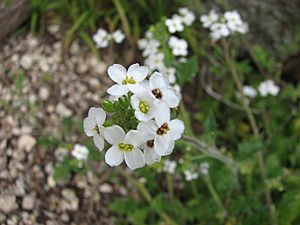Sand cress facts for kids
Quick facts for kids Sand cress |
|
|---|---|
 |
|
| Pachymitus cardaminoides at Terrick Terrick National Park | |
| Scientific classification | |
| Genus: |
Pachymitus
|
| Species: |
cardaminoides
|
| Synonyms | |
|
|
Pachymitus is a special type of plant genus in the mustard family, known as Brassicaceae. It's called a monotypic genus because it only has one known species. That single species is Pachymitus cardaminoides, which many people call sand cress. This plant naturally grows in Australia. You can find it in the states of New South Wales, Victoria, and South Australia.
Contents
What is Sand Cress?
Pachymitus cardaminoides is a small plant. It is a type of herbaceous shrub. This means it has soft stems, not woody ones like a tree. It can grow up to 30 centimeters (about 12 inches) tall.
Where Does Sand Cress Grow?
This plant likes to grow in inland areas. You can find it in the drier parts of New South Wales, Victoria, and South Australia. It often grows in sandy soils, which is why it's sometimes called "sand cress."
How Was Sand Cress Discovered?
The first time this plant was officially collected was near the mouth of the Murray River in Australia. This happened a long time ago.
Who Named Sand Cress?
A famous botanist named Ferdinand von Mueller first described this plant in 1855. He gave it the scientific name Sisymbrium cardaminoides. Later, in 1924, another scientist named Otto Eugen Schulz created the genus Pachymitus. He then moved the plant into this new genus, giving it its current name, Pachymitus cardaminoides.

